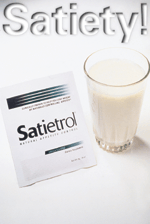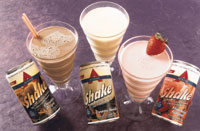
Americans spend more than $50 billion on weight loss products and programs. Recent statistics show that 61% of adult Americans are overweight. According to the Center for Disease Control and Prevention (CDC), more than a third of adults, 35%, are slightly or moderately overweight, and more than a quarter of Americans, 26%, are considered obese.
"High carbs-lowfat" diet, "low carbs-high protein" diet--what's a food formulator to do? While the food industry has spent a great deal of time and money developing non-fat and lowfat foods and a variety of fat replacers, clearly these are not helping Americans to control their body weight.
An obesity expert and those developing innovative products--all in the name of reducing the girth of Americans' waistlines--provide us with insight into the world of weight control products.
Can't Get No Satisfaction
The words from the song certainly pertain to hungry dieters. For almost two decades, boosting satiety with fewer calories has been the field of research for Barbara Rolls, Ph.D., who holds the Guthrie Chair in Nutrition at Pennsylvania State University. The culmination of her research studies was published last year in her book, co-authored by Robert A. Barnett,The Volumetrics Weight-Control Plan: Feel Full on Fewer Calories. Volumetrics tells its readers: "you can eat more for the same calories" and "it's a lifestyle plan, not a diet."Research studies have shown that, on average, people eat the same weight of food over a day or two, even when the calories differ. Therefore, if one maintains the same amount of food and lowers the calories in each portion, one will consume fewer calories and feel just as full.
From a biochemical perspective, cholecystokinin (CCK) is a protein that makes us feel full or satisfied. CCK has been shown to be an important regulator of appetite in humans, working directly on the appetite control center of the brain. Following food consumption, CCK is released from cells in the small intestine. Its release reduces appetite by slowing the movement of food from the stomach to promote the feeling of fullness. It also acts on nerves in the stomach lining that tell the brain the stomach is full.
Rolls advocates consuming foods of lower energy density to lose weight and maintain desired body weight. Energy density (E.D.) is calculated as number of calories divided by the number of grams per serving. Comparing an energy density of 1.0 to 2.0 for two different foods, consumers would get twice as many calories from the same serving size of the food with E.D. 2.0. Very low energy-dense foods include most fruits, vegetables, skim milk, and broth-based soups. High energy-dense foods include crackers, chips, cookies, and butter.
"Reducing the energy density of prepared foods could be an attainable goal for food manufacturers," says Rolls. "In our lab, we have formulated good-tasting lower energy density foods by adding more vegetables and substituting lower fat ingredients. Sensory studies show when we lower the energy density by as much as 30%, people cannnot tell the difference."
Although it is not listed on the Nutrition Facts panel, energy density can be calculated from looking at the information on the panel. Rolls hopes that someday E.D. will be listed.
Rolls' studies show that foods with more air, such as shakes prepared with a blender and lowfat frozen desserts, provide more satiety. Nutritionists have known for years that protein enhances satiety better than fats and carbohydrates, which have the same satiation value. Rolls advises 0.4 grams protein/pound of body weight for health and satiety.

Satisfying Hunger
While theVolumetricsapproach does not require its followers to purchase special packets of food, other weight loss methods require the purchase of products to follow a specific plan.Satietrol® is a new weight loss product sold in 18.5 gram packets from Pacific Health Laboratories (PHL) Inc., Woodbridge, N.J. The product, sold as a dietary supplement, helps people feel full and eat less (see www.hungeroff.com). Satietrol stimulates CCK release in a calorically efficient way and also extends its effect.
In the past, the effects of CCK could only be measured when given by injection because stomach or pancreatic enzymes inactivate it. PHL researchers developed a way to stimulate CCK with a blend of nutritional ingredients that are given orally.
According to PHL's clinical trials, Satietrol decreased hunger up to 35% for as long as 3.5 hours after eating and produced an average weight loss of almost nine pounds in six weeks.
Satietrol is a pre-meal beverage that is sold as a powder. Consumers must mix the powder (vanilla or chocolate) with water or another beverage, and drink it 10 to 15 minutes before lunch or dinner.
"Our studies show that if you add Satietrol to food, you increase the satiation quality of that food," says Robert Portman, Ph.D., president, CEO, and co-founder of Pacific Health Laboratories. "In a recent study, when we added Satietrol to lowfat yogurt, it dramatically reduced hunger and increased satiety over time."
The combination of seven ingredients is part of Satietrol's patented formula, three of which stimulate CCK and four that extend the action of the product, says Portman. To stimulate CCK release, Satietrol contains glycomacropeptide, a protein derived from casein digestion, calcium and a small amount of oleic acid from sunflower oil.
Whereas protein and fat stimulate CK release, bile salts inhibit release. Certain fibers bind bile salts and may prevent the inhibition of CCK release. Satietrol contains two soluble fibers, guar gum and glucomannan from konjac flour, as well as potato fiber, and plant saponins from alfalfa to extend the action of CCK by binding bile salts.
"These ingredients prevent CCK from being switched off to provide an extended feeling of fullness after a meal," says Portman.
Diet Survivors
Some diet plans have been around for a long time. Robert C. Atkins, M.D., a cardiologist, developed the original Atkins diet in the early 1970s. While the principles are the same--eating nutrient dense, low carbohydrate foods--the goal is to make it easier to find low carbohydrate options for those following the Atkins diet and for those limiting sugar and carbohydrate intake. The Atkins diet advocates 20 grams of carbohydrates per day with unlimited protein and fat intake.Atkins Nutritionals Inc., New York, offers a variety of food and beverage products such as nutritional bars, RTD shakes and shake mixes, and sugar-free syrups.
"Our products give people a greater variety of low carbohydrate alternatives that haven't been available until now," says Richard Hirsch, vice president of marketing and sales for Atkins Nutritionals.
While the Atkins plan is carbohydrate limiting, Hirsch says that adding some fiber to the mixes helps add bulk and satiety value.
Sidebar: Designer Oils May Help Prevent Weight Gain
While too much fat in the body poses various health problems, a little fat of the "proper" type can be a good thing. So-called "designer oils" can reduce low-density lipoprotein (LDL) and increase energy expenditure to prevent weight gain.Forbes Medi-Tech Inc., Vancouver, B.C., Canada, recently developed a "designer oil" with phytosterol-based functional food ingredient Phytrol™. Phytosterols are lipid-like compounds found in plants. They have been clinically proven to reduce cholesterol levels. The designer oil also contains medium-chain triglycerides (MCTs) and omega 3 fatty acids.
The FDA recently issued an interim final rule for a health claim for plant sterols and stanols. In May 2000, the FDA cleared Phytrol™ for use in foods under the GRAS notification process.
A study at McGill University involved overweight women that were served Forbes' designer oil or regular oils in a randomized, crossover trial over a 28-day period. Participants who consumed meals containing the designer oil showed a reduction in their LDL cholesterol by 14.5% as compared to subjects consuming regular oils in their diet.
As an additional benefit, the test subjects burned about one-half to three-quarters of a pound of fat per month. "This seemingly small weight loss adds up if you consider the weight loss over a ten-year period. A person can go from being obese to normal weight," says Peter Jones, Ph.D., professor, School of Dietetics and Human Nutrition, McGill University, Montreal, Canada, and the principal researcher of the study.
Various types of fats and oils such as MCTs have been considered as potentially useful in weight management for the past several decades. They are commonly derived from coconut oil, which naturally contains about 65% medium-chain fatty acids. MCTs are less likely to be stored in adipose tissue because of their biochemistry. They offer a caloric content of about 5-7 kcal/gram.
"This product offers wide potential applications as cooking oil and salad dressing as well as a potential to replace fat in various food products," says Jerzy Zawistowski, Ph.D., vice president, functional foods and nutraceuticals, Forbes Medi-Tech.
Currently, Phytrol is included in foods such as cereal bars and soy drinks in the U.S. and Australia.